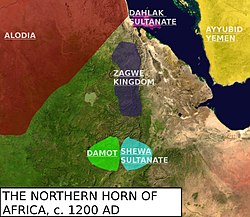Kingdom of Damot
Kingdom of Damot | |||||||||||||
|---|---|---|---|---|---|---|---|---|---|---|---|---|---|
| 1100–1317 | |||||||||||||
 The kingdom of Damot and its neighbours | |||||||||||||
| Capital | Damot | ||||||||||||
| Common languages | Sidama??, Wolayta?? | ||||||||||||
| Religion | Pagan | ||||||||||||
| Government | Monarchy | ||||||||||||
| Motalami | |||||||||||||
| History | |||||||||||||
• Established | 1100 | ||||||||||||
• Disestablished | 1317 | ||||||||||||
| |||||||||||||
The Kingdom of Damot (Amharic: ዳሞት) was a medieval kingdom in what is now Ethiopia, and ruled by Welayta people or Sidama.[1][2] The territory was positioned below the Blue Nile.[3] It was a powerful state that forced the Sultanate of Showa to pay tax and annihilated Zagwe dynasty armies sent to subdue the region. Damot had conquered several Muslim and Christian territories.[4] Muslim Shewa and the new Christian state under Yekuno Amlak formed an alliance to counter influence of Damot in the region.[5] Damot seized as an independent entity after the conquest of the region by Emperor Amda Seyon in the fourteenth century and remained under the Solomonic dynasty's influence of power thereon.[6] Originally located south of the Abay and west of the Muger River,[7] under the pressure of Oromo attacks the rulers were forced to resettle north of the Abay in southern Gojjam between 1574 and 1606.[8]
The kings, who bore the title Motalami, resided in a town which, according to the hagiography of Tekle Haymanot, was called Malbarde.[9] The kingdom was reduced to smaller size and the name became the Kingdom of Wolayta. Their territory extended east beyond the Muger as far as the Jamma.[7]
References
- ^ Shinn, David (2013). Historical Dictionary of Ethiopia. Scarecrow Press. p. 111.
- ^ Tolo, Arne (1998). Sidama and Ethiopian: the emergence of the Mekane Yesus Church in Sidama. Uppsala Universitet. p. 26.
- ^ Shillington, Kevin. Encyclopedia of African History 3-Volume Set. Routledge.
- ^ Bounga, Ayda (2014). The kingdom of Damot: An Inquiry into Political and Economic Power in the Horn of Africa (13th c.). Annales D'ethiopie. p. 262.
- ^ Hassen, Mohammed. Oromo of Ethiopia (PDF). University of London. p. 4.
- ^ Quirin, James (1992). The evolution of the Ethiopian Jews: a history of the Beta Israel (Falasha) to 1920. University of Pennsylvania Press. p. 43.
- ^ a b G.W.B. Huntingford, Historical Geography of Ethiopia from the first century AD to 1704 (London: British Academy, 1989), p. 69
- ^ The dates for this movement are discussed by Huntingford in his Historical Geography, at pp. 143f
- ^ Bouanga 2014, pp. 33–37.
Further reading
- Bouanga, Ayda (2013). Le Damot dans l'histoire de l'Ethiopie (XIIIe-XXe siècles) : recompositions religieuses, politiques et historiographiques (in French). Université Panthéon-Sorbonn.
{{cite book}}: Invalid|ref=harv(help) - Bouanga, Ayda (2014). "Le royaume du Damot : enquête sur une puissance politique et économique de la Corne de l'Afrique (XIIIe siècle)" (PDF). Annales d'Ethiopie (in French). 29: 27–58. doi:10.3406/ethio.2014.1557.
{{cite journal}}: Invalid|ref=harv(help)
